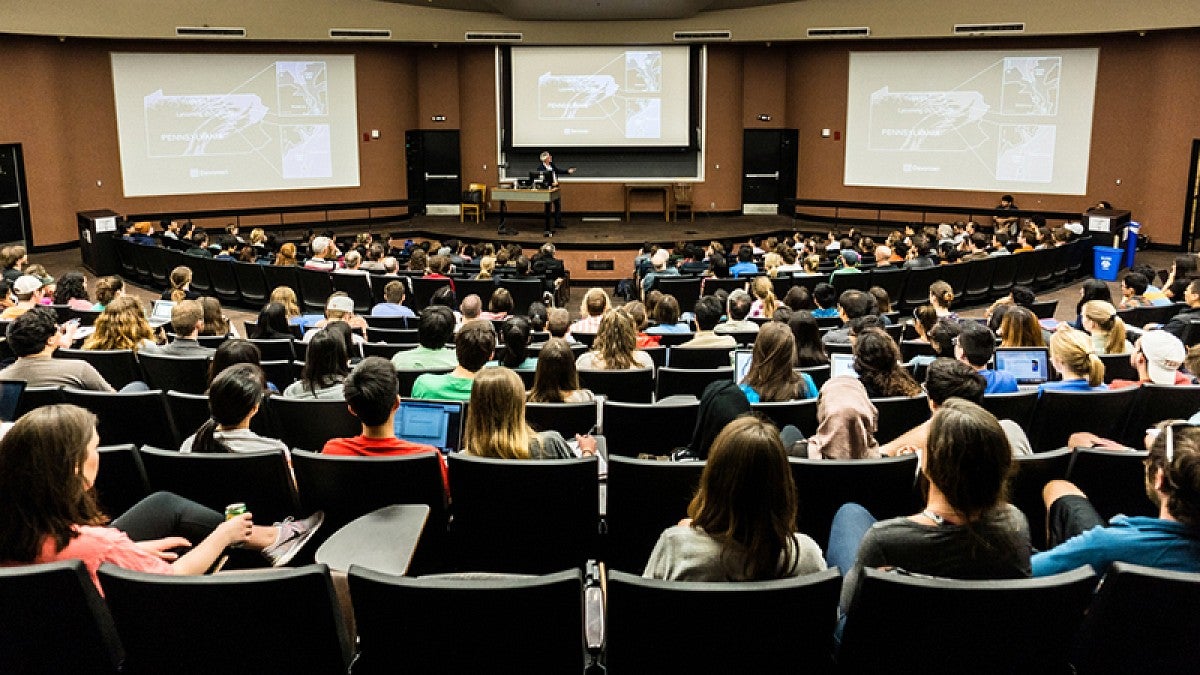A seed for growing student engagement in large undergraduate courses was planted at the University of Oregon last fall. Amid early blooms were shifts in students embracing group-learning activities and in men’s attitudes toward women.
The pilot project, led by Mark Van Ryzin of the College of Education, introduced cooperative learning into large classes where students sometimes are disconnected from their classmates, many of whom are strangers, as they are lectured on a subject’s key concepts. With cooperative learning, students work in small teams to discuss nuggets of new material.
Van Ryzin, though, was actually seeking payoffs beyond improved learning in the project, done with assistance from the UO’s Teaching Engagement Program. While professors and graduate employees inserted strategies that they’d learned about cooperative learning into their lectures, Van Ryzin quietly sought to harvest reductions in misogyny and sexual harassment.
Surveys of students in participating courses in philosophy, architecture, chemistry, child studies, foreign language and theater arts uncovered changes during fall term that reached or trended toward statistical significance in five measures related to sexism, sex roles and sexual harassment. By term’s end, there was more willingness to work with other students, regardless of gender, race or familiarity, and reductions in sexist and harassment attitudes among men. Results were based on data from 120 students who completed surveys before and after the term.
RELATED LINKS
“My goal was to see if we could realize promising signs of attitude changes, and if we can teach instructors at the UO to use this approach and feel confident about it,” said Van Ryzin, who is based in the Department of Educational Methodology, Policy, and Leadership. “The faculty members who participated taught their usual content, just differently.”
The unfunded project was Van Ryzin’s first test of cooperative learning at a university level. He has used the approach, which he studied at the University of Minnesota, where it was developed, in several rural Oregon middle schools. Its use there reduced bullying and alcohol and tobacco use by bringing together students from different peer groups as they learn.
“I absolutely believe now that large class size doesn’t mean that lecture is the best, or only feasible, approach to teaching,” said Camisha Russell, an assistant professor in the Department of Philosophy, who tried cooperative learning in a course on social and political philosophy. “I am incredibly grateful to Mark and his trainer for what I learned. I think it has already made me a better teacher.”
Russell divided her students into random groups of three on major reading assignments, ensuring that all students at some point were in the lead as they focused on philosophical texts for 20 minutes before reporting to the class.
“I was pleased with the level of engagement this weekly activity fostered,” she said. “I believe that it promoted stronger comprehension than lecture alone would have done.”
Maile Hutterer, assistant professor in the Department of the History of Art and Architecture, used cooperative learning in both her lectures and discussion sessions led by graduate employees in two fall courses.
“I did not find it difficult to integrate aspects of the practice into the large lecture,” she said. “In general, I found cooperative learning to be a highly valuable experience that worked for the majority of students. While I cannot speak to how it was used in discussion sessions, it was my impression that a larger percentage of students were actively engaged during lectures.”
In a childhood studies course, Jeanne Nagayama Hall set up base groups of three students. Each group rotated as to who would start a discussion. Students also engaged in brief pair-share discussions with students outside their groups, such those sitting in front or behind them.
“Students in a consistent base group were more individually accountable, engaged in relevant critical conversations and more inclined to share their own thoughts — and the thoughts of other base group members — with the entire class,” said Hall, a senior instructor in the Department of Education Studies. “After discussions within their own base groups, students were more inclined to revise or add content to their own individual papers or projects.”
Based on positive feedback, Hall plans to include a base-group strategy in all her classes.
Jason Schreiner, a faculty consultant and assistant director for graduate programs in the Teaching Engagement Program, said Van Ryzin’s study is worthy of larger-scale research. It’s another approach, he said, that is in line with a growing effort across campus to foster more interactive and connected classrooms.
“We believe that excellent teaching is inclusive, engaged and research-led, informed by research on how people learn and influenced by UO's research mission,” said Schreiner, who observed training sessions before classes started. “We were excited to learn about Van Ryzin's research into the intentional building of classroom community and use of cooperative learning strategies. We will be following the results of his work closely and looking for ways to bring these promising practices to our faculty.”
Van Ryzin’s project did not include control groups for comparing data, nor did it look at academic outcomes. But Van Ryzin noted that previous research on cooperative learning, mostly in primary and secondary schools, has documented significant improvements.
He now is seeking funding to do a full-scale randomized study on the UO campus.
“The results from this pilot study demonstrate that cooperative learning can be implemented by university faculty members without extensive training and to a degree where they feel comfortable and confident,” Van Ryzin said. “The results also suggest that this approach could have positive impacts on student attitudes and reduce prejudices toward other people whom they may not have regular contact with.”
—By Jim Barlow, University Communications


